2004 ISUZU TF SERIES display
[x] Cancel search: displayPage 1776 of 4264
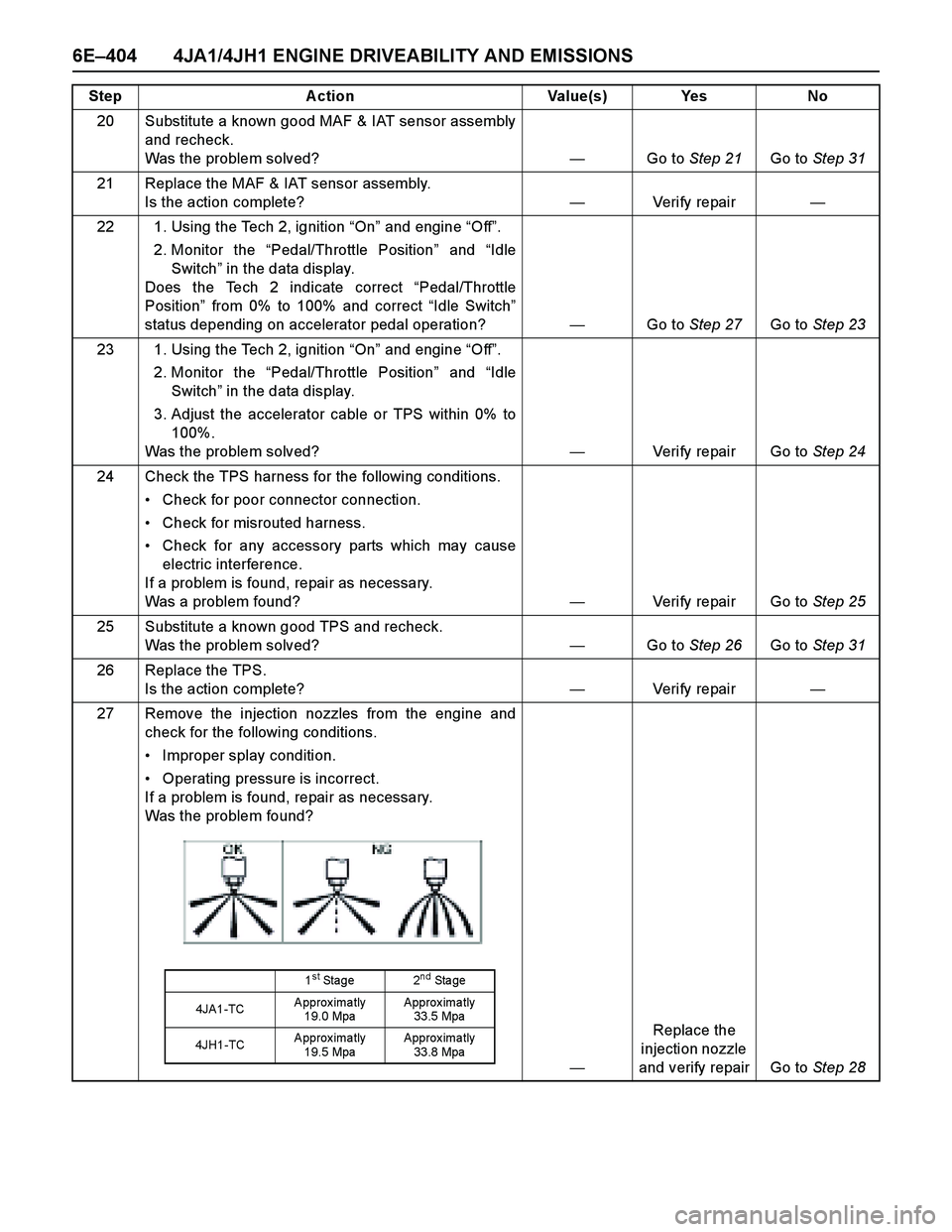
6E–404 4JA1/4JH1 ENGINE DRIVEABILITY AND EMISSIONS
20 Substitute a known good MAF & IAT sensor assembly
and recheck.
Was the problem solved?—Go to Step 21Go to Step 31
21 Replace the MAF & IAT sensor assembly.
Is the action complete?—Veri fy repai r—
22 1. Using the Tech 2, ignition “On” and engine “Off”.
2. Monitor the “Pedal/Throttle Position” and “Idle
Switch” in the data display.
Does the Tech 2 indicate correct “Pedal/Throttle
Position” from 0% to 100% and correct “Idle Switch”
status depending on accelerator pedal operation?—Go to Step 27Go to Step 23
23 1. Using the Tech 2, ignition “On” and engine “Off”.
2. Monitor the “Pedal/Throttle Position” and “Idle
Switch” in the data display.
3. Adjust the accelerator cable or TPS within 0% to
100%.
Was the problem solved?—Verify repair Go to Step 24
24 Check the TPS harness for the following conditions.
Check for poor connector connection.
Check for misrouted harness.
Check for any accessory parts which may cause
electric interference.
If a problem is found, repair as necessary.
Was a problem found? —Verify repair Go to Step 25
25 Substitute a known good TPS and recheck.
Was the problem solved?—Go to Step 26Go to Step 31
26 Replace the TPS.
Is the action complete?—Veri fy repai r—
27 Remove the injection nozzles from the engine and
check for the following conditions.
Improper splay condition.
Operating pressure is incorrect.
If a problem is found, repair as necessary.
Was the problem found?
—Replace the
injection nozzle
and verify repair Go to Step 28 Step Action Value(s) Yes No
1st Stage 2nd Sta ge
4JA1-TCApproximatly
19.0 MpaApprox ima tly
33.5 Mpa
4JH1-TCApproximatly
19.5 MpaApprox ima tly
33.8 Mpa
Page 1779 of 4264
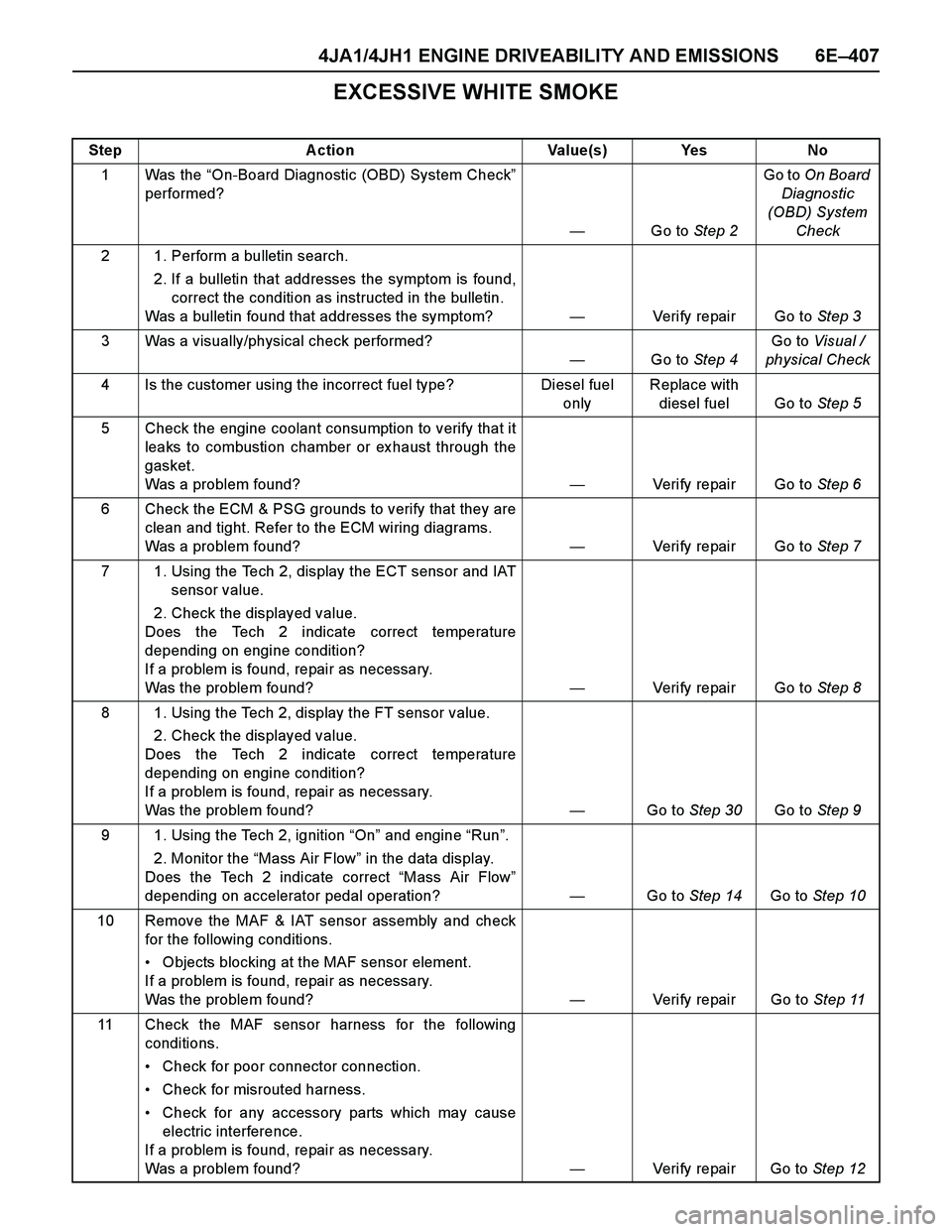
4JA1/4JH1 ENGINE DRIVEABILITY AND EMISSIONS 6E–407
EXCESSIVE WHITE SMOKE
Step Action Value(s) Yes No
1Was the “On-Board Diagnostic (OBD) System Check”
performed?
—Go to Step 2Go to On Board
Diagnostic
(OBD) System
Check
2 1. Perform a bulletin search.
2. If a bulletin that addresses the symptom is found,
correct the condition as instructed in the bulletin.
Was a bulletin found that addresses the symptom?—Verify repair Go to Step 3
3 Was a visually/physical check performed?
—Go to Step 4Go to Visual /
physical Check
4 Is the customer using the incorrect fuel type? Diesel fuel
onlyReplace with
diesel fuel Go to Step 5
5 Check the engine coolant consumption to verify that it
leaks to combustion chamber or ex haust through the
gasket.
Was a problem found?—Verify repair Go to Step 6
6 Check the ECM & PSG grounds to verify that they are
clean and tight. Refer to the ECM wiring diagrams.
Was a problem found?—Verify repair Go to Step 7
7 1. Using the Tech 2, display the ECT sensor and IAT
sensor value.
2. Check the displayed value.
Does the Tech 2 indicate correct temperature
depending on engine condition?
If a problem is found, repair as necessary.
Was the problem found?—Verify repair Go to Step 8
8 1. Using the Tech 2, display the FT sensor value.
2. Check the displayed value.
Does the Tech 2 indicate correct temperature
depending on engine condition?
If a problem is found, repair as necessary.
Was the problem found?—Go to Step 30Go to Step 9
9 1. Using the Tech 2, ignition “On” and engine “Run”.
2. Monitor the “Mass Air Flow” in the data display.
Does the Tech 2 indicate correct “Mass Air Flow”
depending on accelerator pedal operation? —Go to Step 14Go to Step 10
10 Remove the MAF & IAT sensor assembly and check
for the following conditions.
Objects blocking at the MAF sensor element.
If a problem is found, repair as necessary.
Was the problem found?—Verify repair Go to Step 11
11 Check the MAF sensor harness for the following
conditions.
Check for poor connector connection.
Check for misrouted harness.
Check for any accessory parts which may cause
electric interference.
If a problem is found, repair as necessary.
Was a problem found? —Verify repair Go to Step 12
Page 1780 of 4264
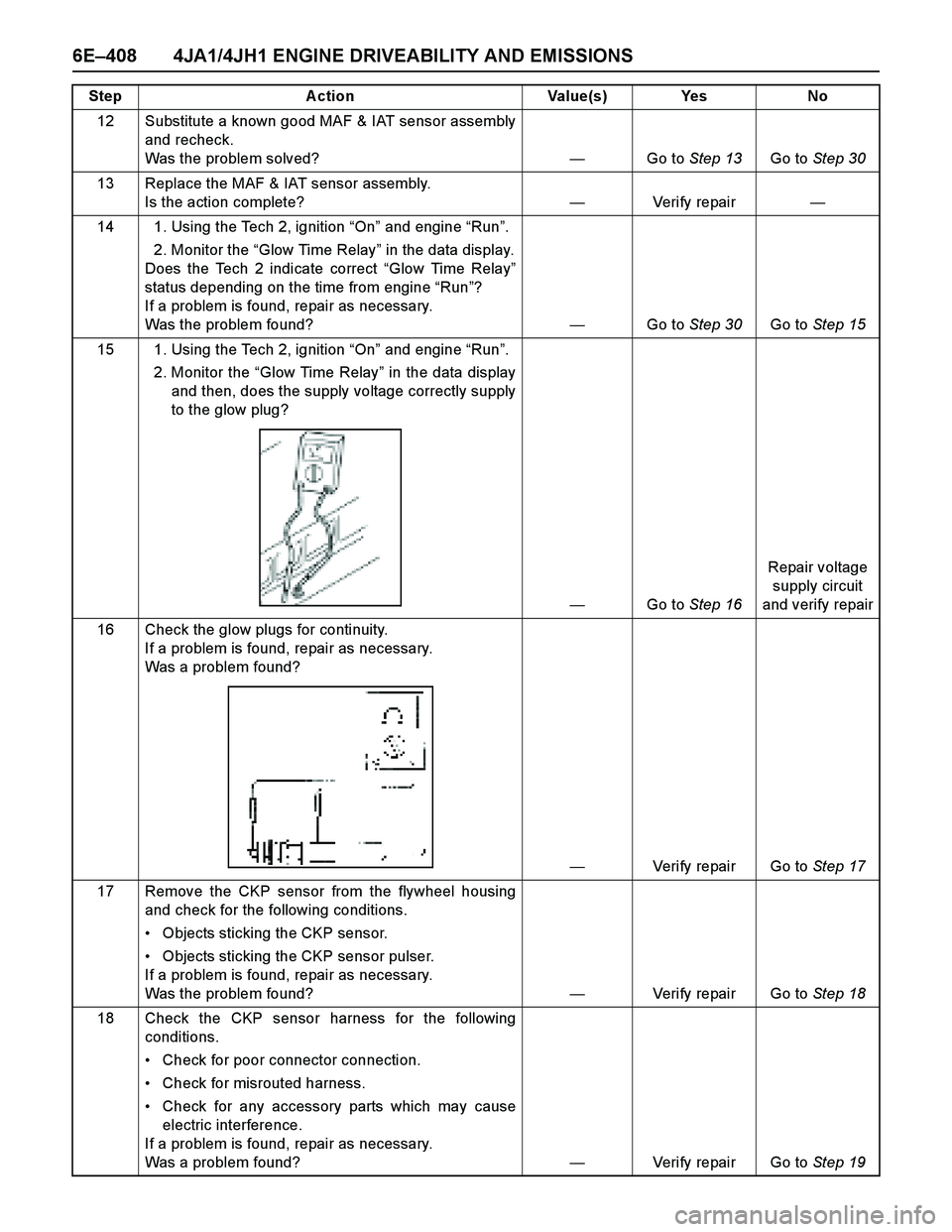
6E–408 4JA1/4JH1 ENGINE DRIVEABILITY AND EMISSIONS
12 Substitute a known good MAF & IAT sensor assembly
and recheck.
Was the problem solved?—Go to Step 13Go to Step 30
13 Replace the MAF & IAT sensor assembly.
Is the action complete?—Veri fy repai r—
14 1. Using the Tech 2, ignition “On” and engine “Run”.
2. Monitor the “Glow Time Relay” in the data display.
Does the Tech 2 indicate correct “Glow Time Relay”
status depending on the time from engine “Run”?
If a problem is found, repair as necessary.
Was the problem found?—Go to Step 30Go to Step 15
15 1. Using the Tech 2, ignition “On” and engine “Run”.
2. Monitor the “Glow Time Relay” in the data display
and then, does the supply voltage correctly supply
to the glow plug?
—Go to Step 16Repair voltage
supply circuit
and verify repair
16 Check the glow plugs for continuity.
If a problem is found, repair as necessary.
Was a problem found?
—Verify repair Go to Step 17
17 Remove the CKP sensor from the flywheel housing
and check for the following conditions.
Objects sticking the CKP sensor.
Objects sticking the CKP sensor pulser.
If a problem is found, repair as necessary.
Was the problem found? —Verify repair Go to Step 18
18 Check the CKP sensor harness for the following
conditions.
Check for poor connector connection.
Check for misrouted harness.
Check for any accessory parts which may cause
electric interference.
If a problem is found, repair as necessary.
Was a problem found? —Verify repair Go to Step 19 Step Action Value(s) Yes No
Page 1781 of 4264

4JA1/4JH1 ENGINE DRIVEABILITY AND EMISSIONS 6E–409
19 Substitute a known good CKP sensor and recheck.
Was the problem solved?—Go to Step 20Go to Step 21
20 Replace the CKP sensor.
Is the action complete?—Veri fy repai r—
21 1. Using the Tech 2 and ignition “On” and engine
“Run”.
2. Monitor the following parameters in the data
display.
“Desired Injection Quantity” & “Injection Quantity”
“Desired Injection Start” & “Actual Injection Start”
Are the large gap or unstable parameter displayed
between “Desired” and “Actual”?
—Go to Step 23Go to Step 22
22 Check the ex haust system for a possible restriction.
Damaged or collapsed pipes or catalytic converter.
Internal muffler failure.
If a problem is found, repair as necessary.
Was a problem found?—Verify repair Go to Step 23
23 Visually/physically inspect for the following conditions.
Restrict fuel supply system. Check for a pinched
fuel hose/pipe.
Check for a condition that causes fuel wax ing or
icing, such as the customer is using an incorrect
fuel type in winter season or water mix ed with the
fuel.
If a problem is found, repair as necessary.
Was a problem found?—Verify repair Go to Step 24
24 Replace the fuel filter.
Was the problem solved?—Verify repair Go to Step 25 Step Action Value(s) Yes No
When idling or part-throttle When accelerated
HighDesi red
Low
Ti m e Actu al
High
LowDe si red
Actu al
Time
Page 1785 of 4264
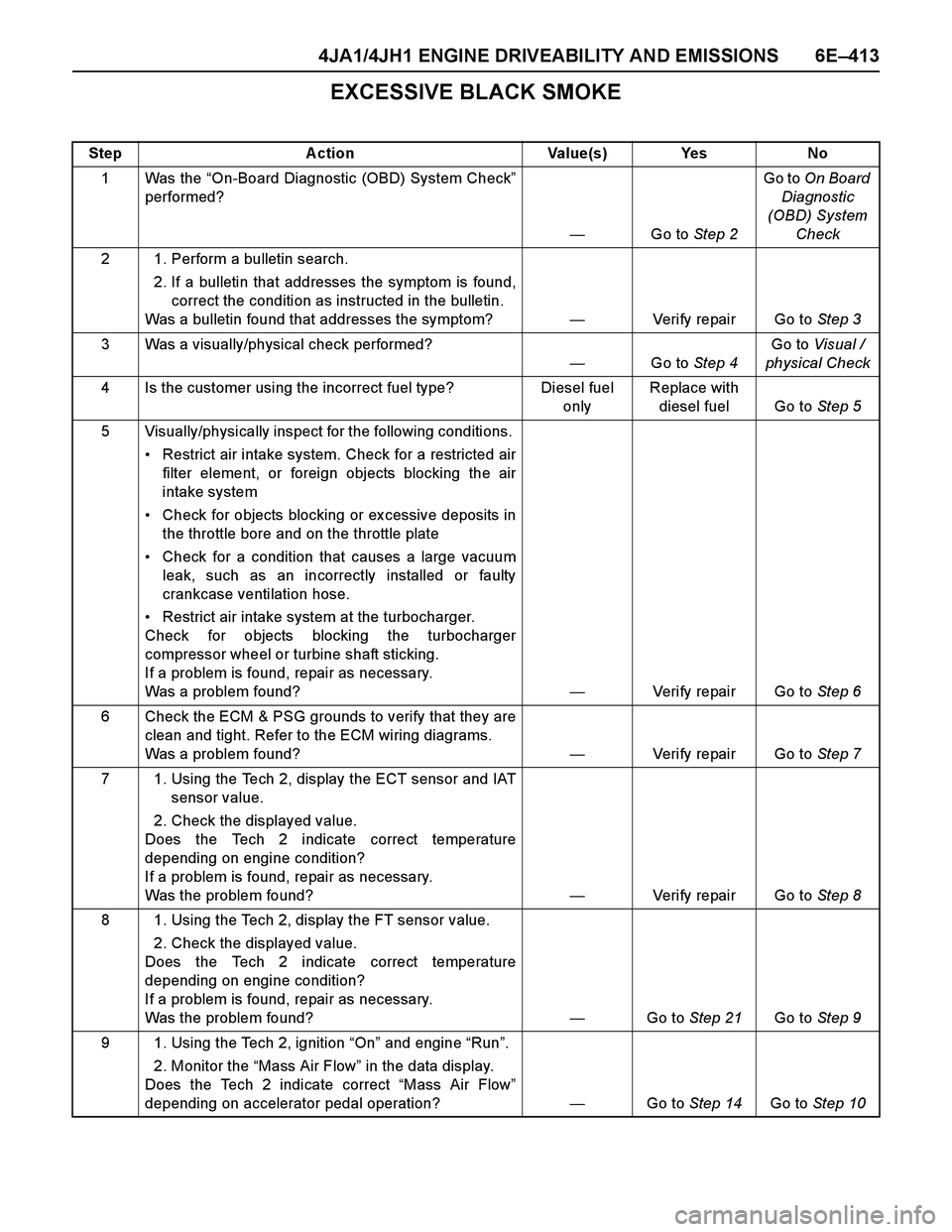
4JA1/4JH1 ENGINE DRIVEABILITY AND EMISSIONS 6E–413
EXCESSIVE BLACK SMOKE
Step Action Value(s) Yes No
1Was the “On-Board Diagnostic (OBD) System Check”
performed?
—Go to Step 2Go to On Board
Diagnostic
(OBD) System
Check
2 1. Perform a bulletin search.
2. If a bulletin that addresses the symptom is found,
correct the condition as instructed in the bulletin.
Was a bulletin found that addresses the symptom?—Verify repair Go to Step 3
3 Was a visually/physical check performed?
—Go to Step 4Go to Visual /
physical Check
4 Is the customer using the incorrect fuel type? Diesel fuel
onlyReplace with
diesel fuel Go to Step 5
5 Visually/physically inspect for the following conditions.
Restrict air intake system. Check for a restricted air
filter element, or foreign objects blocking the air
intake system
Check for objects blocking or ex cessive deposits in
the throttle bore and on the throttle plate
Check for a condition that causes a large vacuum
leak, such as an incorrectly installed or faulty
crankcase ventilation hose.
Restrict air intake system at the turbocharger.
Check for objects blocking the turbocharger
compressor wheel or turbine shaft sticking.
If a problem is found, repair as necessary.
Was a problem found?—Verify repair Go to Step 6
6 Check the ECM & PSG grounds to verify that they are
clean and tight. Refer to the ECM wiring diagrams.
Was a problem found?—Verify repair Go to Step 7
7 1. Using the Tech 2, display the ECT sensor and IAT
sensor value.
2. Check the displayed value.
Does the Tech 2 indicate correct temperature
depending on engine condition?
If a problem is found, repair as necessary.
Was the problem found?—Verify repair Go to Step 8
8 1. Using the Tech 2, display the FT sensor value.
2. Check the displayed value.
Does the Tech 2 indicate correct temperature
depending on engine condition?
If a problem is found, repair as necessary.
Was the problem found?—Go to Step 21Go to Step 9
9 1. Using the Tech 2, ignition “On” and engine “Run”.
2. Monitor the “Mass Air Flow” in the data display.
Does the Tech 2 indicate correct “Mass Air Flow”
depending on accelerator pedal operation? —Go to Step 14Go to Step 10
Page 1786 of 4264
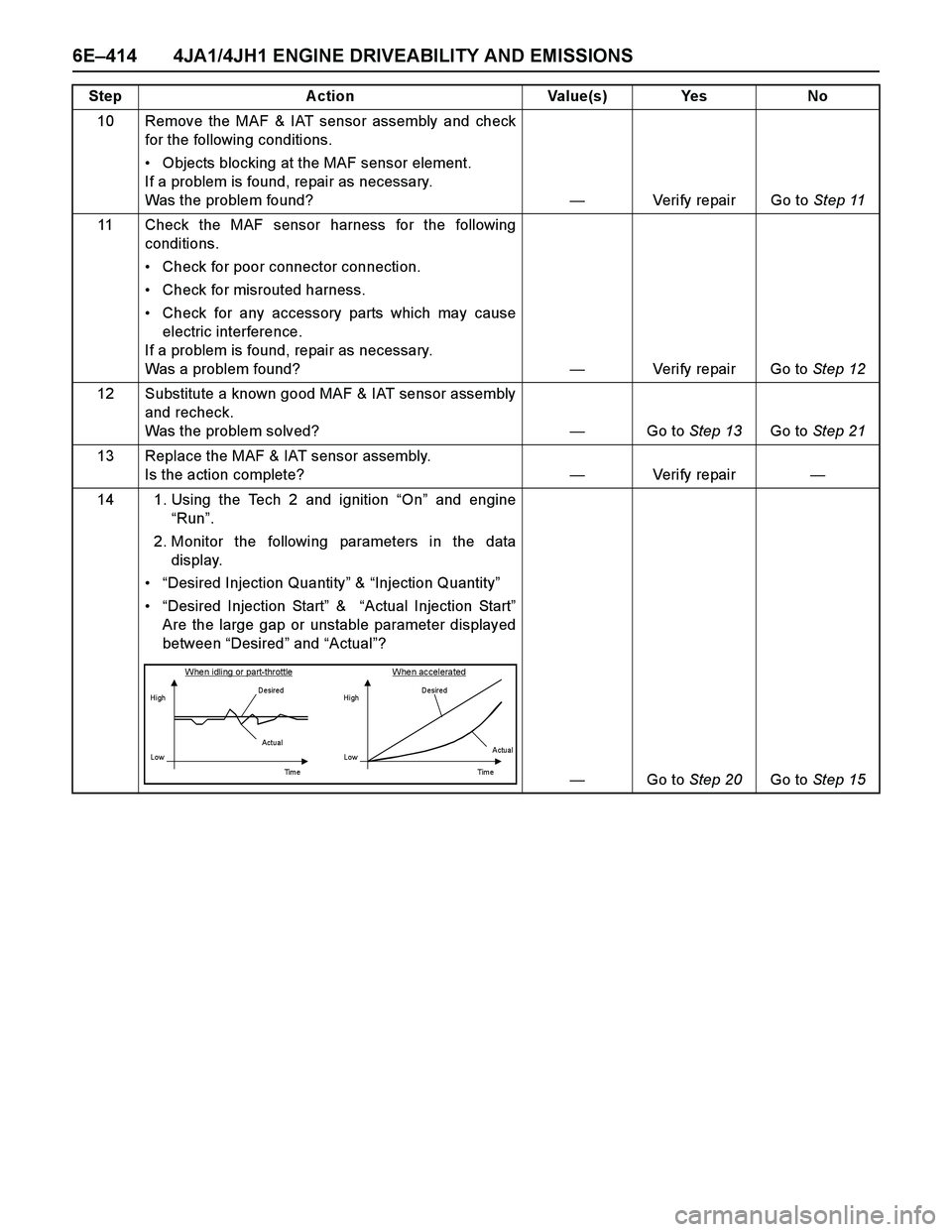
6E–414 4JA1/4JH1 ENGINE DRIVEABILITY AND EMISSIONS
10 Remove the MAF & IAT sensor assembly and check
for the following conditions.
Objects blocking at the MAF sensor element.
If a problem is found, repair as necessary.
Was the problem found?—Verify repair Go to Step 11
11 Check the MAF sensor harness for the following
conditions.
Check for poor connector connection.
Check for misrouted harness.
Check for any accessory parts which may cause
electric interference.
If a problem is found, repair as necessary.
Was a problem found? —Verify repair Go to Step 12
12 Substitute a known good MAF & IAT sensor assembly
and recheck.
Was the problem solved?—Go to Step 13Go to Step 21
13 Replace the MAF & IAT sensor assembly.
Is the action complete?—Veri fy repai r—
14 1. Using the Tech 2 and ignition “On” and engine
“Run”.
2. Monitor the following parameters in the data
display.
“Desired Injection Quantity” & “Injection Quantity”
“Desired Injection Start” & “Actual Injection Start”
Are the large gap or unstable parameter displayed
between “Desired” and “Actual”?
—Go to Step 20Go to Step 15 Step Action Value(s) Yes No
When idling or part-throttle When accelerated
HighD esired
Low
Ti m e Actu al
High
LowD esired
Actual
Tim e
Page 1792 of 4264
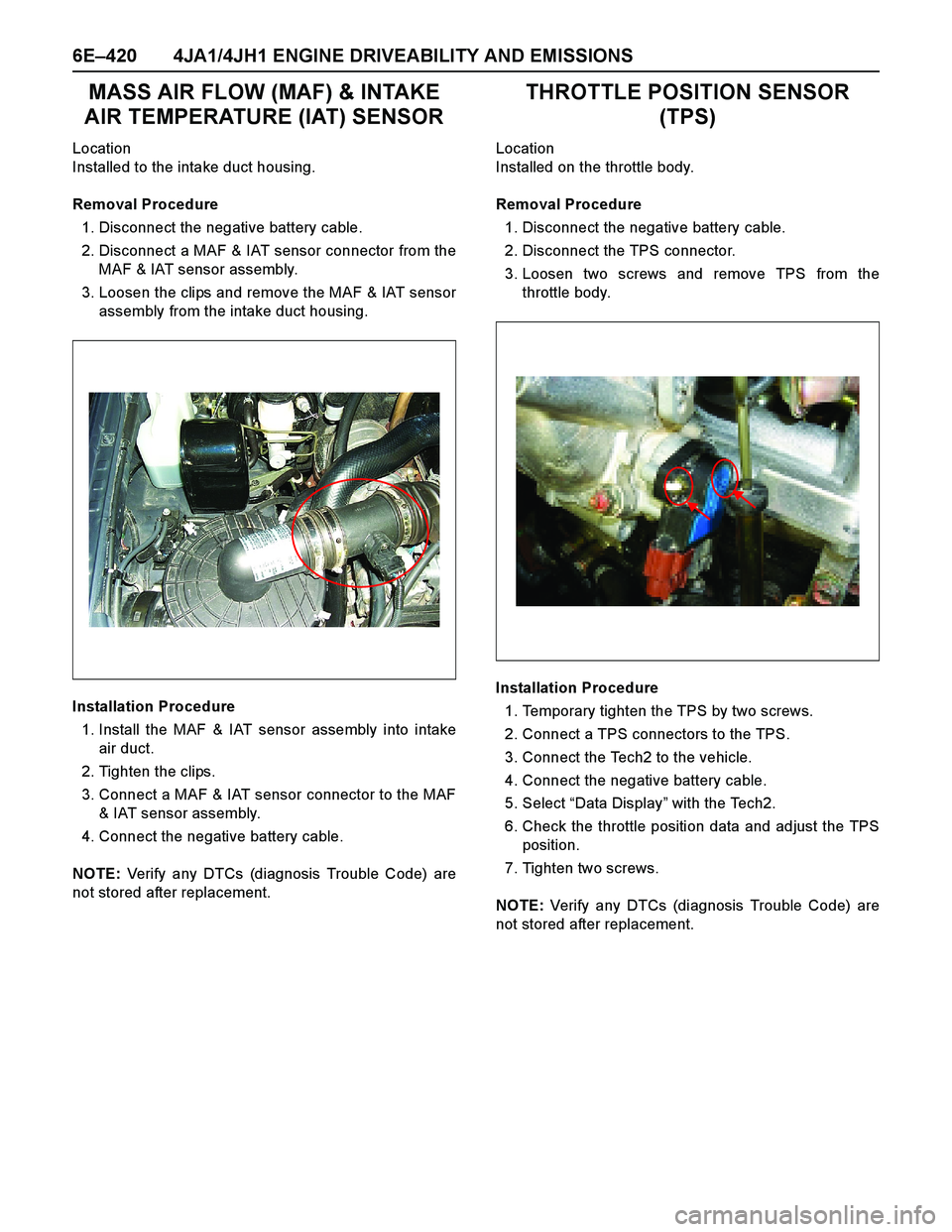
6E–420 4JA1/4JH1 ENGINE DRIVEABILITY AND EMISSIONS
MASS AIR FLOW (MAF) & INTAKE
AIR TEMPERATURE (IAT) SENSOR
Location
Installed to the intake duct housing.
Removal Procedure
1. Disconnect the negative battery cable.
2. Disconnect a MAF & IAT sensor connector from the
MAF & IAT sensor assembly.
3. Loosen the clips and remove the MAF & IAT sensor
assembly from the intake duct housing.
Installation Procedure
1. Install the MAF & IAT sensor assembly into intake
air duct.
2. Tighten the clips.
3. Connect a MAF & IAT sensor connector to the MAF
& IAT sensor assembly.
4. Connect the negative battery cable.
NOTE: Verify any DTCs (diagnosis Trouble Code) are
not stored after replacement.
THROTTLE POSITION SENSOR
(TPS)
Location
Installed on the throttle body.
Removal Procedure
1. Disconnect the negative battery cable.
2. Disconnect the TPS connector.
3. Loosen two screws and remove TPS from the
throttle body.
Installation Procedure
1. Temporary tighten the TPS by two screws.
2. Connect a TPS connectors to the TPS.
3. Connect the Tech2 to the vehicle.
4. Connect the negative battery cable.
5. Select “Data Display” with the Tech2.
6. Check the throttle position data and adjust the TPS
position.
7. Tighten two screws.
NOTE: Verify any DTCs (diagnosis Trouble Code) are
not stored after replacement.
Page 1998 of 4264
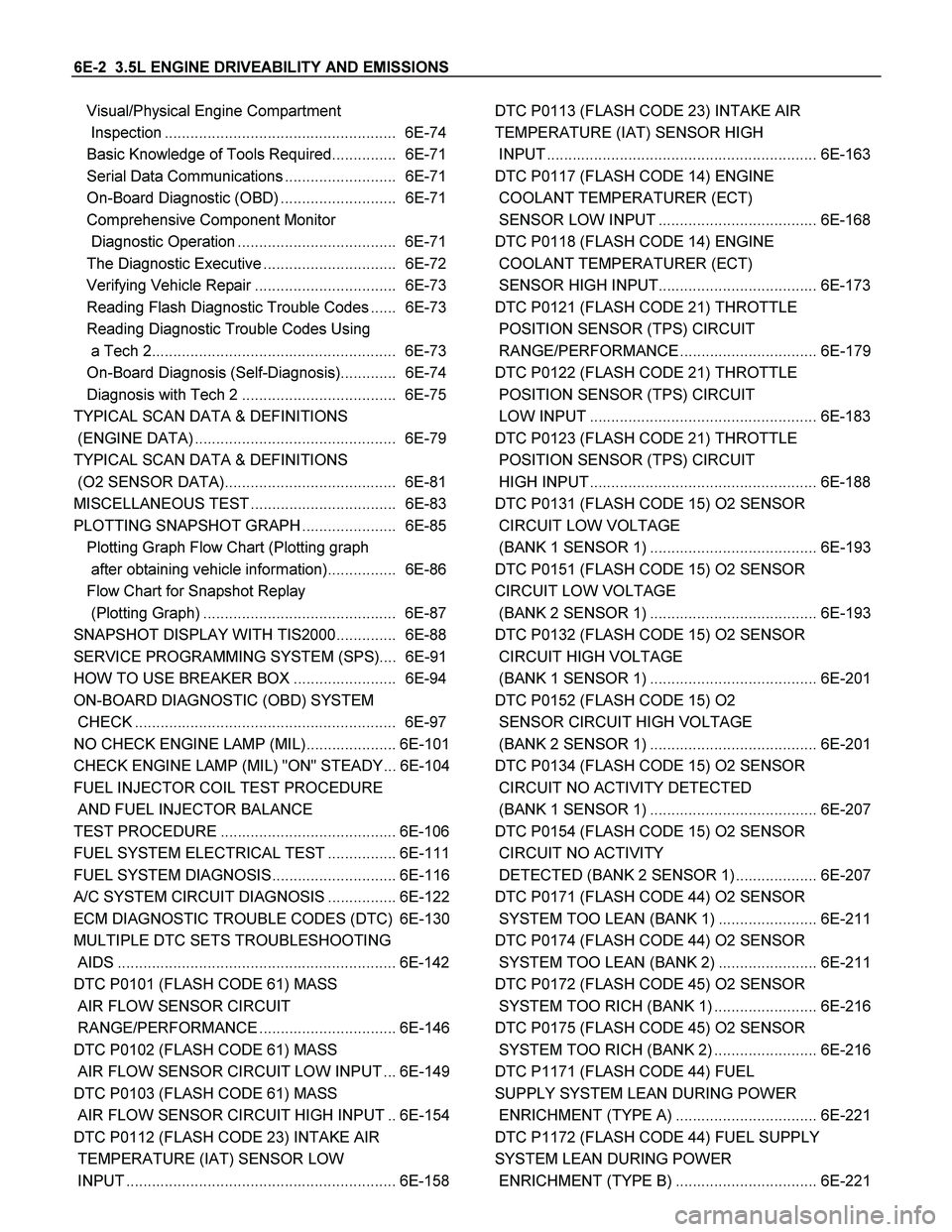
6E-2 3.5L ENGINE DRIVEABILITY AND EMISSIONS
Visual/Physical Engine Compartment
Inspection ...................................................... 6E-74
Basic Knowledge of Tools Required............... 6E-71
Serial Data Communications .......................... 6E-71
On-Board Diagnostic (OBD) ........................... 6E-71
Comprehensive Component Monitor
Diagnostic Operation ..................................... 6E-71
The Diagnostic Executive ............................... 6E-72
Verifying Vehicle Repair ................................. 6E-73
Reading Flash Diagnostic Trouble Codes ...... 6E-73
Reading Diagnostic Trouble Codes Using
a Tech 2......................................................... 6E-73
On-Board Diagnosis (Self-Diagnosis)............. 6E-74
Diagnosis with Tech 2 .................................... 6E-75
TYPICAL SCAN DATA & DEFINITIONS
(ENGINE DATA) ............................................... 6E-79
TYPICAL SCAN DATA & DEFINITIONS
(O2 SENSOR DATA)........................................ 6E-81
MISCELLANEOUS TEST .................................. 6E-83
PLOTTING SNAPSHOT GRAPH ...................... 6E-85
Plotting Graph Flow Chart (Plotting graph
after obtaining vehicle information)................ 6E-86
Flow Chart for Snapshot Replay
(Plotting Graph) ............................................. 6E-87
SNAPSHOT DISPLAY WITH TIS2000.............. 6E-88
SERVICE PROGRAMMING SYSTEM (SPS).... 6E-91
HOW TO USE BREAKER BOX ........................ 6E-94
ON-BOARD DIAGNOSTIC (OBD) SYSTEM
CHECK ............................................................. 6E-97
NO CHECK ENGINE LAMP (MIL)..................... 6E-101
CHECK ENGINE LAMP (MIL) "ON" STEADY ... 6E-104
FUEL INJECTOR COIL TEST PROCEDURE
AND FUEL INJECTOR BALANCE
TEST PROCEDURE ......................................... 6E-106
FUEL SYSTEM ELECTRICAL TEST ................ 6E-111
FUEL SYSTEM DIAGNOSIS ............................. 6E-116
A/C SYSTEM CIRCUIT DIAGNOSIS ................ 6E-122
ECM DIAGNOSTIC TROUBLE CODES (DTC) 6E-130
MULTIPLE DTC SETS TROUBLESHOOTING
AIDS ................................................................. 6E-142
DTC P0101 (FLASH CODE 61) MASS
AIR FLOW SENSOR CIRCUIT
RANGE/PERFORMANCE ................................ 6E-146
DTC P0102 (FLASH CODE 61) MASS
AIR FLOW SENSOR CIRCUIT LOW INPUT ... 6E-149
DTC P0103 (FLASH CODE 61) MASS
AIR FLOW SENSOR CIRCUIT HIGH INPUT .. 6E-154
DTC P0112 (FLASH CODE 23) INTAKE AIR
TEMPERATURE (IAT) SENSOR LOW
INPUT ............................................................... 6E-158 DTC P0113 (FLASH CODE 23) INTAKE AIR
TEMPERATURE (IAT) SENSOR HIGH
INPUT ............................................................... 6E-163
DTC P0117 (FLASH CODE 14) ENGINE
COOLANT TEMPERATURER (ECT)
SENSOR LOW INPUT ..................................... 6E-168
DTC P0118 (FLASH CODE 14) ENGINE
COOLANT TEMPERATURER (ECT)
SENSOR HIGH INPUT..................................... 6E-173
DTC P0121 (FLASH CODE 21) THROTTLE
POSITION SENSOR (TPS) CIRCUIT
RANGE/PERFORMANCE ................................ 6E-179
DTC P0122 (FLASH CODE 21) THROTTLE
POSITION SENSOR (TPS) CIRCUIT
LOW INPUT ..................................................... 6E-183
DTC P0123 (FLASH CODE 21) THROTTLE
POSITION SENSOR (TPS) CIRCUIT
HIGH INPUT ..................................................... 6E-188
DTC P0131 (FLASH CODE 15) O2 SENSOR
CIRCUIT LOW VOLTAGE
(BANK 1 SENSOR 1) ....................................... 6E-193
DTC P0151 (FLASH CODE 15) O2 SENSOR
CIRCUIT LOW VOLTAGE
(BANK 2 SENSOR 1) ....................................... 6E-193
DTC P0132 (FLASH CODE 15) O2 SENSOR
CIRCUIT HIGH VOLTAGE
(BANK 1 SENSOR 1) ....................................... 6E-201
DTC P0152 (FLASH CODE 15) O2
SENSOR CIRCUIT HIGH VOLTAGE
(BANK 2 SENSOR 1) ....................................... 6E-201
DTC P0134 (FLASH CODE 15) O2 SENSOR
CIRCUIT NO ACTIVITY DETECTED
(BANK 1 SENSOR 1) ....................................... 6E-207
DTC P0154 (FLASH CODE 15) O2 SENSOR
CIRCUIT NO ACTIVITY
DETECTED (BANK 2 SENSOR 1) ................... 6E-207
DTC P0171 (FLASH CODE 44) O2 SENSOR
SYSTEM TOO LEAN (BANK 1) ....................... 6E-211
DTC P0174 (FLASH CODE 44) O2 SENSOR
SYSTEM TOO LEAN (BANK 2) ....................... 6E-211
DTC P0172 (FLASH CODE 45) O2 SENSOR
SYSTEM TOO RICH (BANK 1) ........................ 6E-216
DTC P0175 (FLASH CODE 45) O2 SENSOR
SYSTEM TOO RICH (BANK 2) ........................ 6E-216
DTC P1171 (FLASH CODE 44) FUEL
SUPPLY SYSTEM LEAN DURING POWER
ENRICHMENT (TYPE A) ................................. 6E-221
DTC P1172 (FLASH CODE 44) FUEL SUPPLY
SYSTEM LEAN DURING POWER
ENRICHMENT (TYPE B) ................................. 6E-221